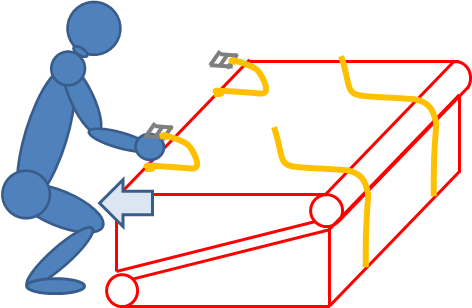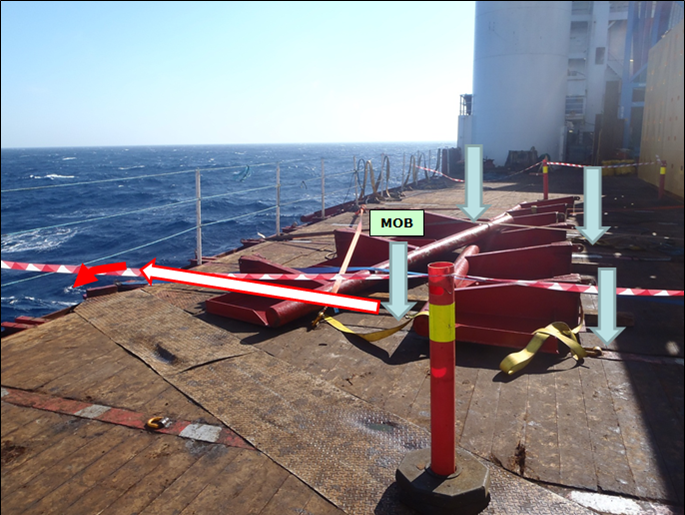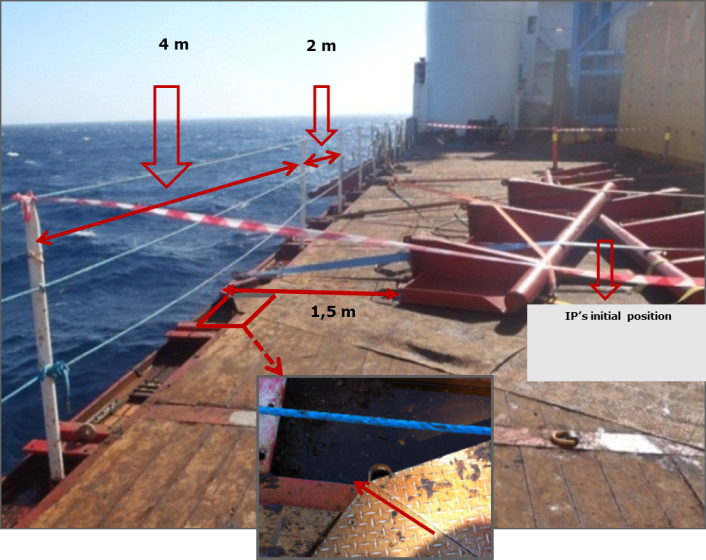Fatality: Man overboard
A member has reported an incident in which a crew member was lost overboard and drowned whilst working on a load on deck near to the side of the vessel. The incident occurred when a team of riggers was working on deck at night securing a load composed of two metal elements (bulwarks) one on top of the other. One of the riggers was approximately 3 metres to one side, in an area where temporary barriers were installed to prevent falling into the sea. During the operation, there was an unexpected movement of the metal structure on the top in the direction of the vessel side. The rigger moved backwards to avoid the movement of the load toward his position; after 2-3 steps back he fell backward and passed through the barriers, falling into the sea.
The rigger was not wearing a life jacket. The sea state was critical (1.25-2.5 metres swell) and he was not able to reach the life buoys that were launched. The rescue craft reached him and recovered him; the casualty was back on board the vessel eight minutes after the MOB alarm had been raised. Unfortunately, efforts to resuscitate him were in vain.



An investigation revealed the following:
- The area where the injured person was working (3m away from side) had been previously risk assessed as ‘safe’ with regard to the risk of falling into the sea, and so the requirement for a life jacket had not been identified for the task;
- During the operation, the worker was positioned ‘in the line of fire’ of the metal bulwark element on the top;
- Temporary barriers were found not appropriate, just beside the workplace of the injured person, due to a missing stanchion for holding barriers.
The following lessons were drawn:
- Risk of fall overboard should be considered not only for work over the side but also for work in close proximity to the side;
- The suitability of temporary barriers should be assessed before the start of the tasks in close proximity;
- Housekeeping should be of the highest standard to eliminate any unnecessary slip, trip and fall hazards; . All personnel taking part in a task should attend a toolbox talk (TBT) and a job safety analysis (JSA) and/or risk assessment (RA) discussion before starting; . In a MOB scenario, a constructive working relationship between marine crew and project crew is vital.
The following corrective actions were taken:
- A new risk assessment for bulwark removal and storage;
- Reinforce implementation of safe system of work;
- Verify vessel search light possible improvements and purchase night visors and personal locator beacons in order to improve the performance of MOB rescue;
- Replacement of missing post in port side temporary over-the-side protection;
- Increase housekeeping control on the deck;
- Complete audit and evaluation of MOB emergency procedure to be carried out utilising all required emergency equipment.
Safety Event
Published: 17 October 2013
Download: IMCA SF 16/13
IMCA Safety Flashes
Submit a Report
IMCA Safety Flashes summarise key safety matters and incidents, allowing lessons to be more easily learnt for the benefit of all. The effectiveness of the IMCA Safety Flash system depends on Members sharing information and so avoiding repeat incidents. Please consider adding safetyreports@imca-int.com to your internal distribution list for safety alerts or manually submitting information on incidents you consider may be relevant. All information is anonymised or sanitised, as appropriate.
IMCA’s store terms and conditions (https://www.imca-int.com/legal-notices/terms/) apply to all downloads from IMCA’s website, including this document.
IMCA makes every effort to ensure the accuracy and reliability of the data contained in the documents it publishes, but IMCA shall not be liable for any guidance and/or recommendation and/or statement herein contained. The information contained in this document does not fulfil or replace any individual’s or Member's legal, regulatory or other duties or obligations in respect of their operations. Individuals and Members remain solely responsible for the safe, lawful and proper conduct of their operations.
